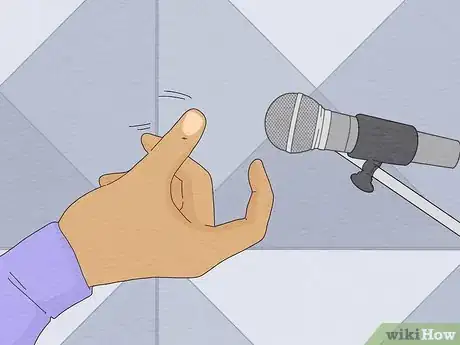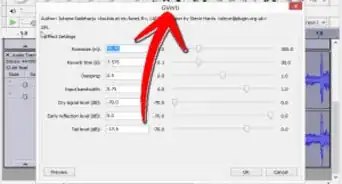This article was co-authored by Tanisha Hall. Tanisha Hall is a Vocal Coach and the Founder and Executive Director of White Hall Arts Academy, Inc. an organization based in Los Angeles, California that offers a multi-level curriculum focused on fundamental skills, technique, composition, theory, artistry, and performance at a conservatory level. Ms. Hall's current and previous students include Galimatias, Sanai Victoria, Ant Clemons, and Paloma Ford. She earned a BA in Music from the Berklee College of Music in 1998 and was a recipient of the Music Business Management Achievement Award.
This article has been viewed 97,814 times.
The way you hold your microphone can have a large effect on both how you sound and feel on stage. Singing with a microphone can take a bit of getting used to. With a little time spent getting to know how the microphone feels and sounds, and practicing with it, you'll soon feel comfortable singing into a microphone.
Steps
Getting Comfortable Holding a Microphone
-
1Practice with objects similar to a microphone. Even if you don’t always have access to a microphone during your solo practice time, you will still get the feel for singing with an object in your hand.
- You can use something like a hairbrush or water bottle to simulate the feeling of holding the microphone while you are singing.[1]
- Microphones are fairly heavy, so use an object with some weight. For example, if you are using a water bottle for practice, use a full water bottle rather than an empty one.
-
2Hold the microphone at a 45-degree angle. The rounded head of the microphone will be next to your mouth.
- Grasp the microphone firmly with all the fingers of the hand of your choice. If you want, you can support the microphone with both hands or switch between hands. Your grip should be firm but not overly tight.
- Don’t grasp any part of the head of the microphone, as this can muffle the sound. Your hand should be around the middle of the microphone.
Advertisement -
3Keep your elbow in towards your body.[2] This is the elbow of the arm holding the microphone. Keeping it close helps to anchor your microphone and keep the sound steady.
- However, don’t hold it so tightly close to you that it restricts your airflow or rib cage expansion while singing.
-
4Use a microphone stand. If you aren’t comfortable holding a microphone, you can ask to use a microphone stand. This keeps your arms free and can help ease your nerves.
- In certain settings, like a recording studio, your microphone will most likely always be on a stand, so you won’t need to worry about holding it.
Singing into Your Microphone
-
1Position the microphone close to your mouth.[3] Vocal microphones are designed for close use. However, you don’t want to touch the microphone with your mouth.
- Optimally, your mouth should be about one to four inches from the center, or axis, of the head of the microphone.
- If you are using a stand, make sure the stand is raised so that the head of the microphone is at the level of your mouth when you are standing up straight. The top of the microphone's head should be directly across from your lower lip.[4] You don't want to have to either raise or lower your chin to sing into the microphone.
-
2Keep your head steady. Because you want your mouth to be pointed towards the center of the microphone, your tone can change if you move your head around too much.
- When you move your head during a performance, make sure that you move your microphone along with your head.
- Alternately, try to keep your head held steady above the microphone.
-
3Maintain your posture.[5] Your posture is an integral part of your sound when you are singing. You want to make sure that your microphone placement allows you to keep your good posture in place.
- Your back and neck should be comfortably straight.
- You don’t want to hunch over your microphone. You also don’t want to have to lift up your chin to sing into your microphone.
-
4Test your microphone.[6] Whether you are recording or performing, you want to test your microphone before you begin and become familiar with it.
- Know how to turn your microphone on. It may seem silly, but you want to make sure you are comfortable with the basics of the specific microphone you are using.
- As you sound check, don’t just say a few words. Sing a portion of your songs, trying to test a range of notes and levels. You want the sound tech to adjust the microphone to your specific voice and tone, rather than you trying to adjust to the microphone.
- Make sure you can hear yourself, whether you’re listening in the speakers or have a headset. If you can’t hear what you are singing, ask the sound tech to adjust your microphone or headset.
- Make sure the sound is clear. Listen for any unwanted feedback. This can be an indication the levels need to be adjusted.
-
5Don’t over or under compensate in volume. You want to sing at your natural level, neither too softly or too loudly.
- Resist the temptation to adjust your distance from the microphone when you sing at different volumes or pitches.
- The microphone should be adjusted to you. You want to sing at a normal volume.
- Don’t feel like you have to hold back on big crescendos just because you’re singing into a microphone.
- When you’re going through sound check, make sure you are singing at the level you’ll be singing during your performance.
Expert Q&A
-
QuestionHow close should you sing to a mic?
 Tanisha HallTanisha Hall is a Vocal Coach and the Founder and Executive Director of White Hall Arts Academy, Inc. an organization based in Los Angeles, California that offers a multi-level curriculum focused on fundamental skills, technique, composition, theory, artistry, and performance at a conservatory level. Ms. Hall's current and previous students include Galimatias, Sanai Victoria, Ant Clemons, and Paloma Ford. She earned a BA in Music from the Berklee College of Music in 1998 and was a recipient of the Music Business Management Achievement Award.
Tanisha HallTanisha Hall is a Vocal Coach and the Founder and Executive Director of White Hall Arts Academy, Inc. an organization based in Los Angeles, California that offers a multi-level curriculum focused on fundamental skills, technique, composition, theory, artistry, and performance at a conservatory level. Ms. Hall's current and previous students include Galimatias, Sanai Victoria, Ant Clemons, and Paloma Ford. She earned a BA in Music from the Berklee College of Music in 1998 and was a recipient of the Music Business Management Achievement Award.
Vocal Coach When you're singing into a microphone, hold it about 1 finger distance from your lips, at a 45° angle to your mouth. You want it to be almost close enough to kiss, but don't actually put your mouth on it. Also, don't cover the top of the microphone, or it will limit how many frequencies the microphone can pick up, and it will muffle the sound.
When you're singing into a microphone, hold it about 1 finger distance from your lips, at a 45° angle to your mouth. You want it to be almost close enough to kiss, but don't actually put your mouth on it. Also, don't cover the top of the microphone, or it will limit how many frequencies the microphone can pick up, and it will muffle the sound. -
QuestionWhen I sing into a microphone it distorts my voice so that it sounds bad. Why?
 Community AnswerIt's normal for some people's voices to sound different when they use microphones. If it is really distorted, try another microphone to see if the mic itself is the problem.
Community AnswerIt's normal for some people's voices to sound different when they use microphones. If it is really distorted, try another microphone to see if the mic itself is the problem. -
QuestionHow do I find a good microphone to sing with?
 Community AnswerGo into a music shop and ask to try out the different microphones they have. Everyone is different so you need to find a microphone that is best suited to your voice, is a microphone fit for purpose (If your going to perform with a microphone, don't get one used for recording), works properly and is long lasting.
Community AnswerGo into a music shop and ask to try out the different microphones they have. Everyone is different so you need to find a microphone that is best suited to your voice, is a microphone fit for purpose (If your going to perform with a microphone, don't get one used for recording), works properly and is long lasting.
Warnings
- Never have your microphone volume really high or you risk damaging your ears.⧼thumbs_response⧽
References
- ↑ http://www.openmicuk.co.uk/advice-for-unsigned-singers/microphone-technique-for-singers#.Vx-6_WM_a7Y
- ↑ http://www.sportsannouncing.com/the-art-of-holding-a-microphone/
- ↑ http://www.singwise.com/cgi-bin/main.pl?section=articles&doc=ChoosingVocalMicrophone&page=2
- ↑ http://www.singwise.com/cgi-bin/main.pl?section=articles&doc=ChoosingVocalMicrophone&page=2
- ↑ http://www.musicconnection.com/improve-live-vocals/
- ↑ http://singerssecret.com/how-to-sound-check-your-vocals/
About This Article
To sing into a microphone, hold it at a 45 degree angle with the head of the microphone about 1-4 inches away from your mouth. If you don’t have a microphone at home, practice how to hold one by using a hairbrush or water bottle, and keep your head steady as you sing to avoid changes in tone. Alternatively, if you have to move your head, make sure you move the microphone as well. You should also sing at your natural volume so the microphone picks up a steady level of sound throughout the song. For tips on how to test your microphone and how to use a microphone stand, read on!





































































